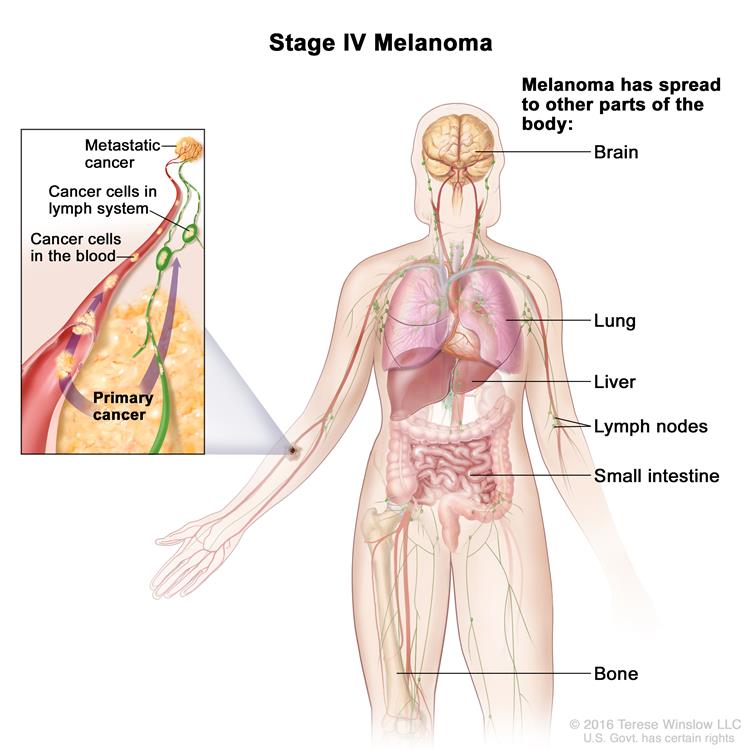Stage IV, is defined by 3 primary characteristics:
1) Location of distant metastases.
2) Number and size of your tumors
3) LDH level.
Stage IV melanoma is determined by the spread beyond the regional lymph nodes to distant sites. It’s important to know within Stage IV, is the location of your different metastases, the number and size of the tumors, and your LDH levels.
So, in Stage IV, your melanoma, has now traveled beyond your original tumor site and past your nearest lymph nodes. The most common sites of metastasis for Stage IV melanoma are distant skin and lymph nodes, lungs, liver, brain, bone, and/or intestines. The level of serum lactate dehydrogenase (LDH: substance found in the blood, that is involved in energy production in cells) in the blood may or may not be elevated. The level of LDH is an important sign, as it usually indicates overall tumor burden and possibly how aggressive the tumor is—in other words, it usually indicates the amount of cancer in the body. LDH levels become a huge factor, for me, during my battle in Stage IV. Is/was it for you?
There are no subgroups for Stage IV but with the TNM system (see Stage III) The final part of that system is, M= metastases. Category M is helpful, so we can try to better understand, Stage IV.
The M categories and subcategories are based on where the metastases are located and the level of LDH. A higher level of LDH generally correlates with higher tumor burden. Details about the primary tumor, such as thickness and ulceration, no longer matter.
* M1a: the tumor has metastasized to distant skin, soft tissue including muscle, and/or to distant lymph nodes.
* M1a(0): LDH not elevated
* M1a(1): LDH elevated
* M1b: the tumor has metastasized to the lungs (with or without M1a sites of disease)
* M1b(0): LDH not elevated
* M1b(1): LDH elevated
* M1c: the tumor has metastasized to internal organs (with or without M1a or M1b sites of disease)
* M1c(0): LDH not elevated
* M1c(1): LDH elevated
* M1d: the tumor has metastasized to the central nervous system (with or without M1a, M1b, or M1c sites of disease)
* M1d(0): LDH not elevated
* M1d(1): LDH elevated
PLEASE SEE A DERMATOLOGIST FOR HELP, IF YOU SEE ANY AREAS OF CONCERN.
Stage IV Survival Data
In 2009, one year survival estimates for patients diagnosed with metastatic disease prior to modern immune and targeted therapies were the following:
Distant skin, soft tissue, and/or lymph nodes – 62%
Lung- 53%
Other visceral sites- 33% (1)
Now, we have 5 year data demonstrating 52% survival rate at 5 years with combination Yervoy/Opdivo, 44% with single-agent Opdivo, and 26% with single-agent Yervoy.(2) Median for disease site subgroups were not reached at time of publication. Targeted therapy with Tafinlar/Mekinist inhibition has also demonstrated a 34% survival rate at 5 years.
Why Brain Metastases Are Different
While brain metastases are part of Stage IV, the risk factors, diagnosis, and treatment, are different than other types of metastases and carry a worse prognosis. Learn more about brain metastases.
Why LDH Levels Are Important
Compared with the survival of patients with normal LDH levels, patients with high LDH levels have significantly worse overall survival.
info- AIMatmelanoma



